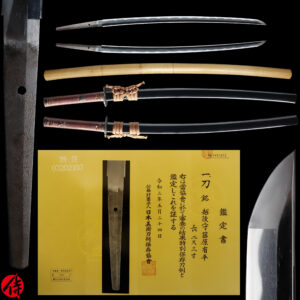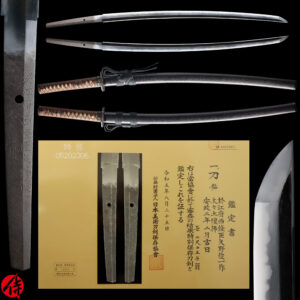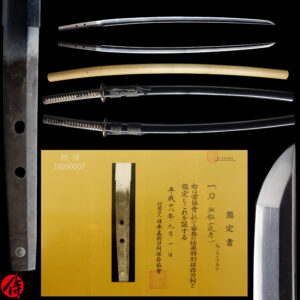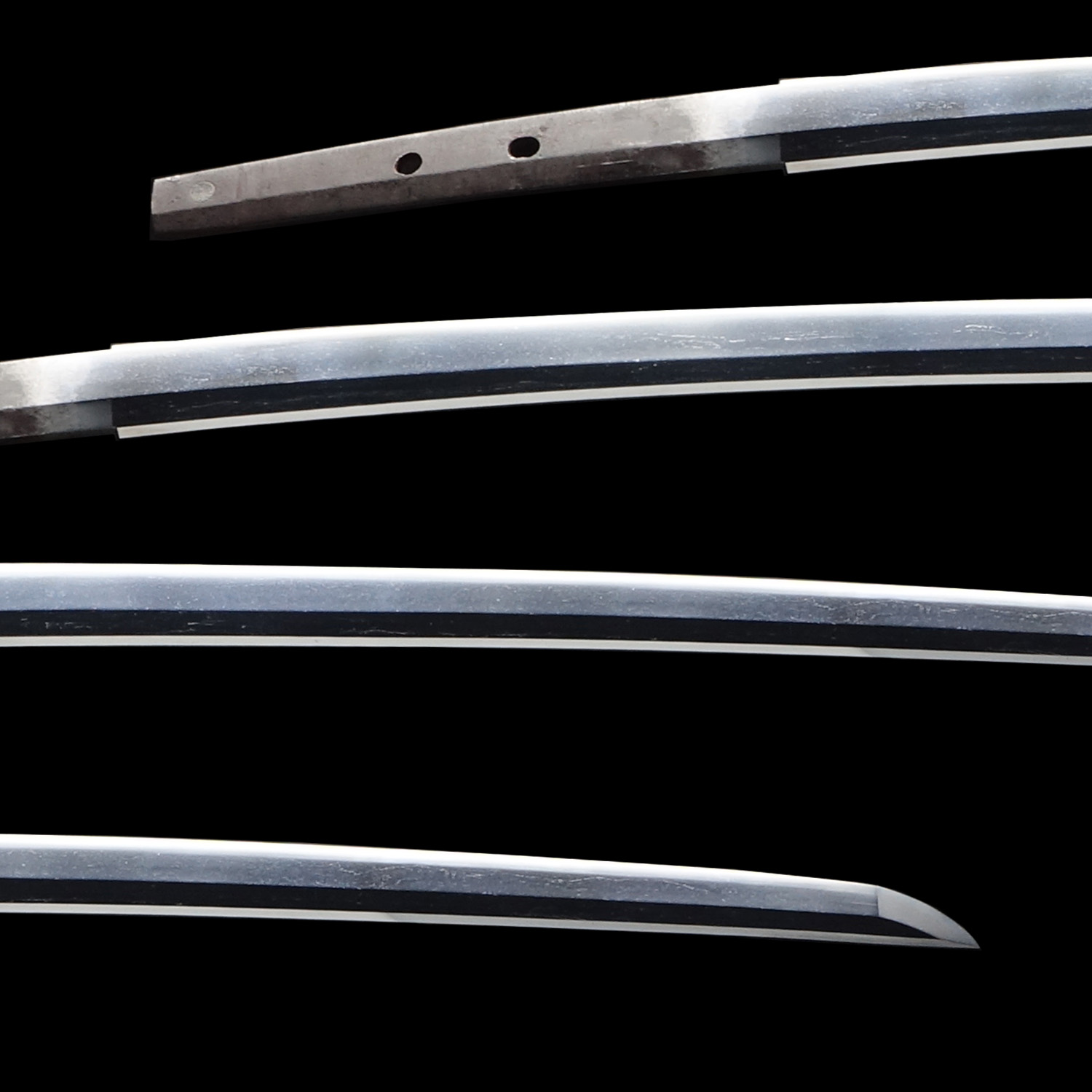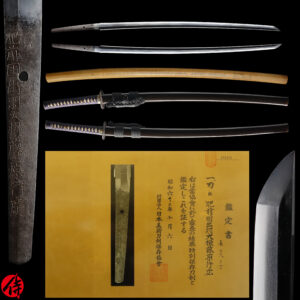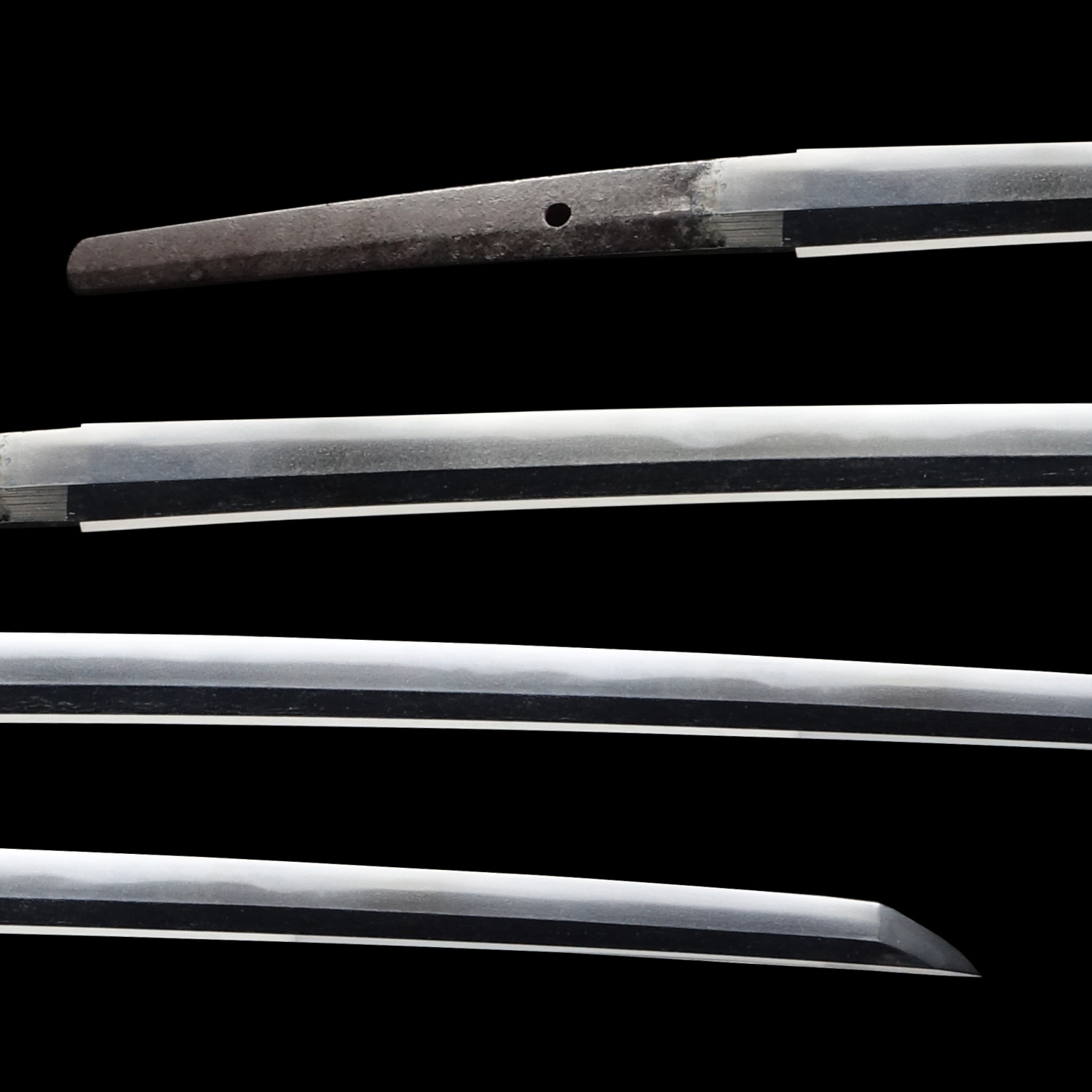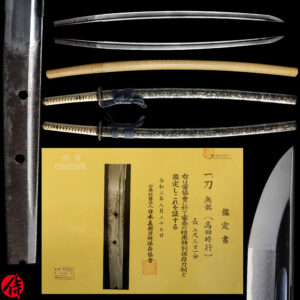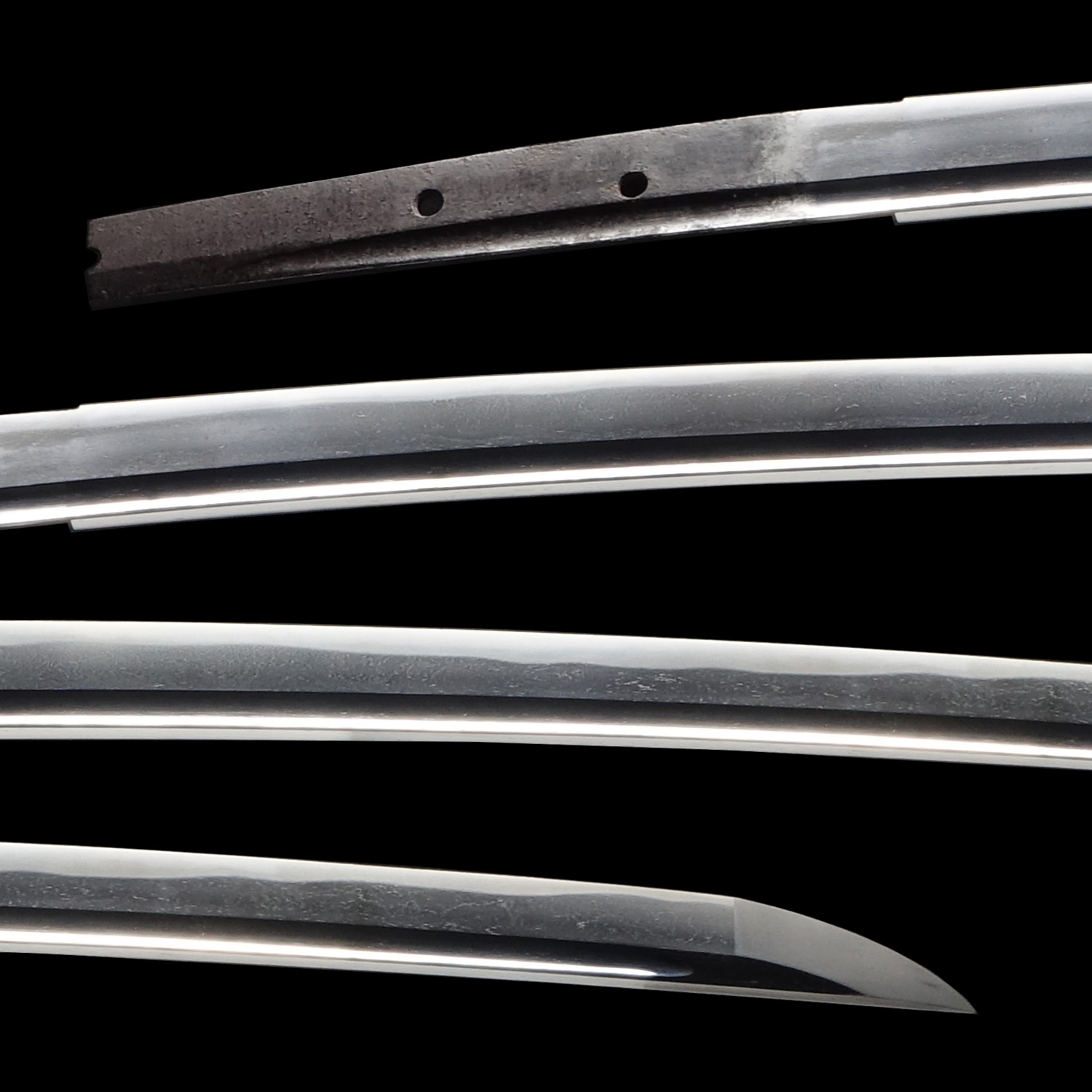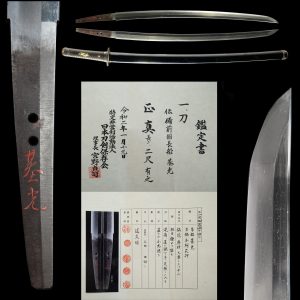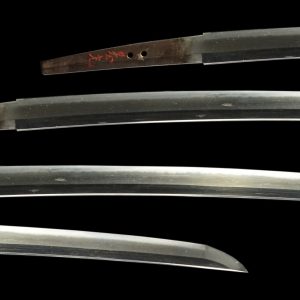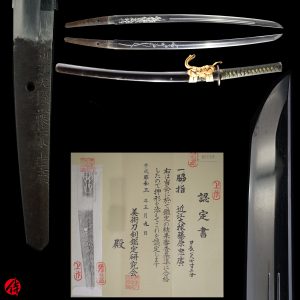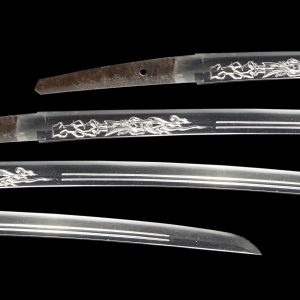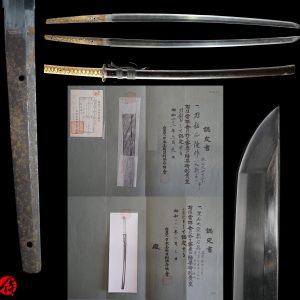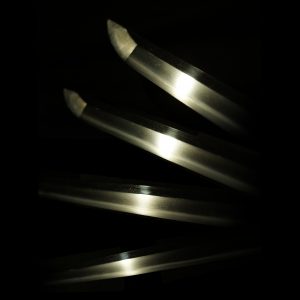Antique Japanese Sword Katana Signed by Fujiwara Kunimichi with Tokubetsu Hozon Certificate
【Description】
This blade was signed by Dewa Daijo Fujiwara Kunimichi (出羽大掾藤原国路), who was especially active during the early Edo period (1615-1658: Genna-Meireki era) in Yamashiro province (Today’s Yamashiro province). It is said that Kunimichi originally belonged to Mishina school at the beginning of his career and later started to serve Horikawa Kunihiro school. He also signed Heianjo Kunimichi (平安城国道), Heianjo Jyu Kunimichi (平安城住国路), Dewa Daijo Fujiwara Rai Kunimichi(出羽大掾藤原来国路).
He was born in the 4th year of the Tensho era (1576: Azuchi Momoyama period). Based on available records, he started to officially appear in Japanese sword history in the 13th year of the Keisho era (1608: The beginning of the Edo period). He first signed Kunimichi (国道). As you can see, the letter of Michi is different from the one seen on this blade. Those who belonged to Mishina (三品) school used Michi (道) as their maker’s names, such as Iga no Kami Kimichi (伊賀守金道). That is why it is believed that Kunimichi originally belonged to Mishina school. Also, at the end of his career, he used Rai (来) in his maker’s name, which is the only characteristic of the swordsmiths who belonged to Mishina school back then.
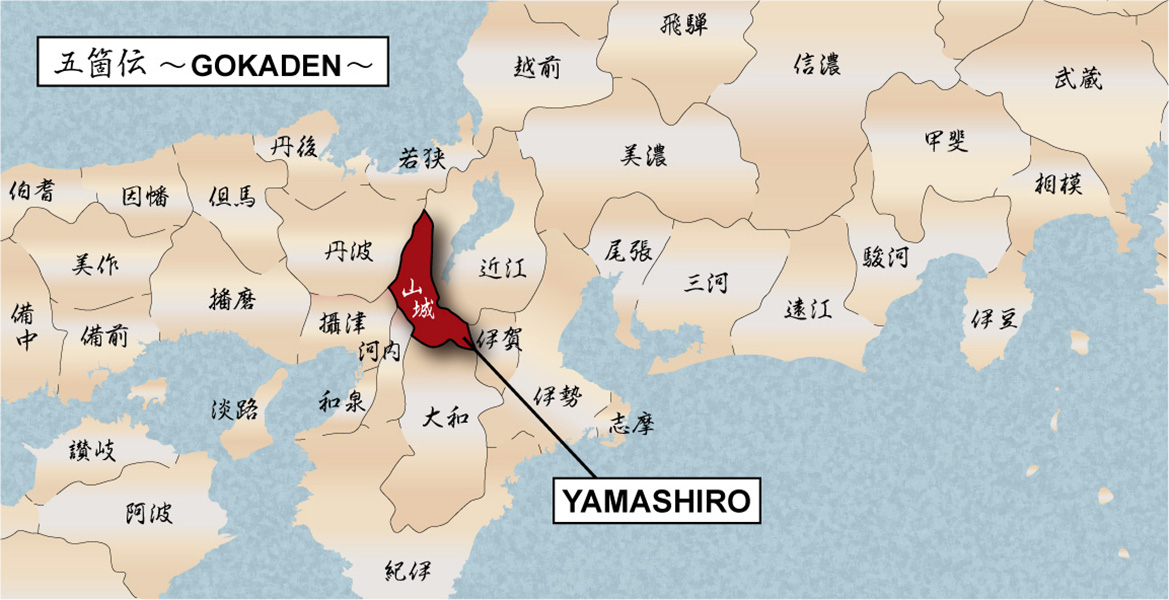
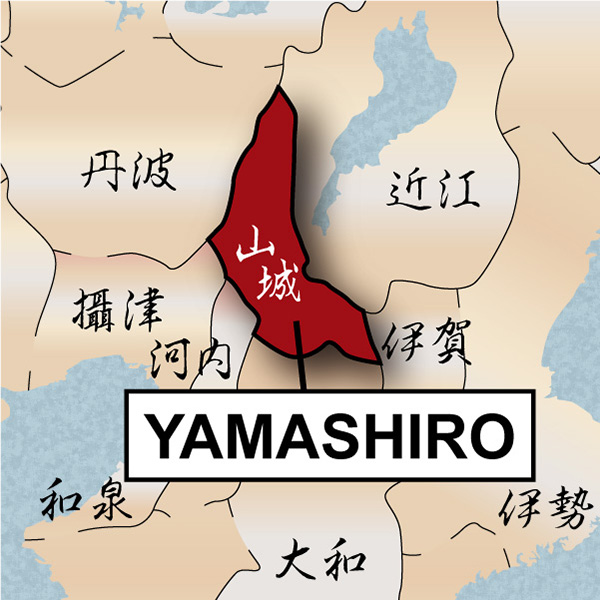
In the 14th year of the Keisho era (1609), he started to use both Kunimichi (国道) and Kunimichi (国路). It is thought that this year was when he shifted his maker’s name to Kunimichi (国路). He received the title of Dawa Daijo (出羽大掾) in the 20th year of the Keisho era (1615). Kami is an honorable official title given by the imperial court for one’s excellent craftsmanship. Since Dewa Daijo is inscribed on this blade, this blade was at least made after 1615 when he had already mastered superb sword-forging techniques.
His master, Horkawa Kunihiro, died in the 18th year of the Kisho era (1613). After his master’s decease, it is said that he started to belong to Mishina school again and learned sword-forging techniques from Iga no Kami Kinmichi.
Kunimichi was one of the most prominent figures in Horikawa Kunihiro school. He was incredibly excellent at forging blades in Mino DEN, one of the five Japanese sword forging traditions. Two of his works are Important Cultural Property, and five of them are Important Artwork, all of which were designated by the Agency for Cultural Affairs.
It is appraised as a Tokubetsu Hozon Token(特別保存刀剣) issued by NBTHK(Nihon Bijutsu Touken Hozon Kyokai:日本美術刀剣保存協会). This authentication paper was only given to authentic Japanese swords, especially well preserved and high quality with artistic value.
【 Blade】
Cutting Edge Length(Nagasa):69.8 cm ( 27.5 inches)
Curvature(Sori): 1.6 cm (0.63 inches)

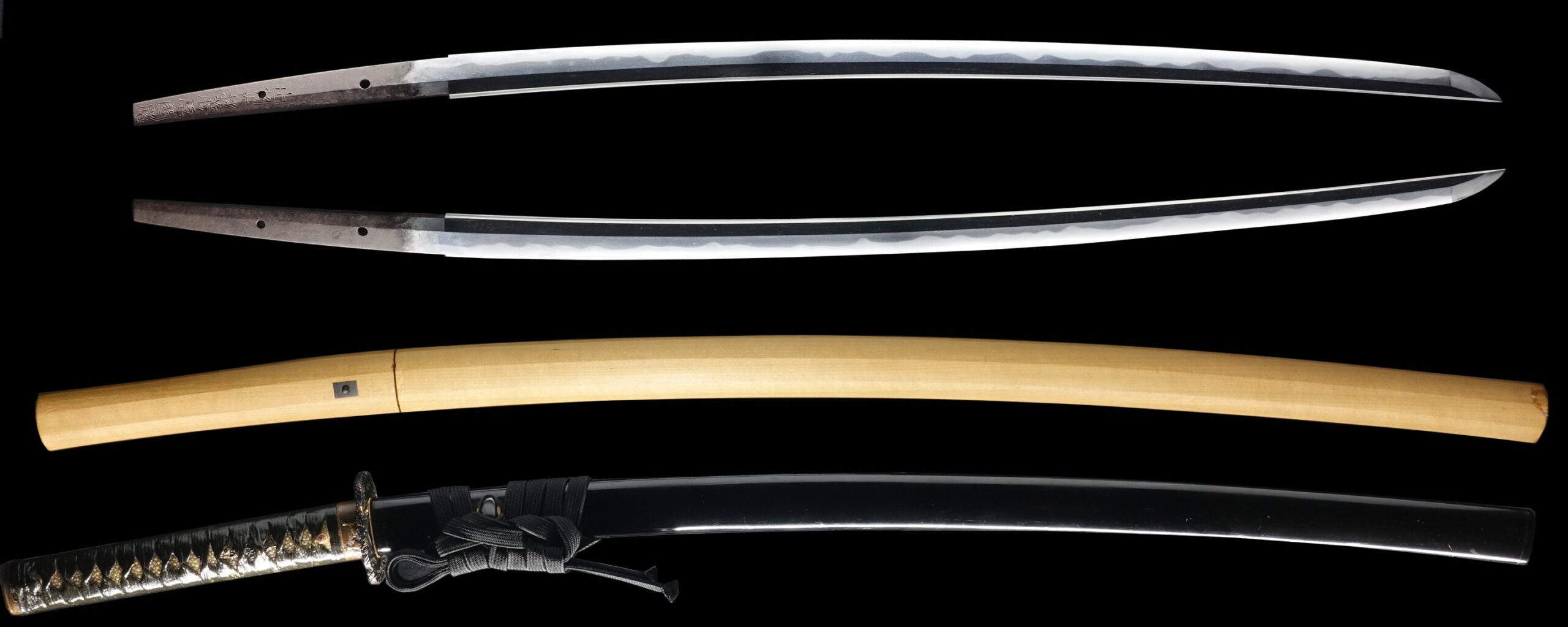
Hamon:
The crystalline structure which forms along the cutting edge of a blade as a result of the hardening process
Jimon(Jihada):
visible steel surface pattern created by folding and hammering during forging process
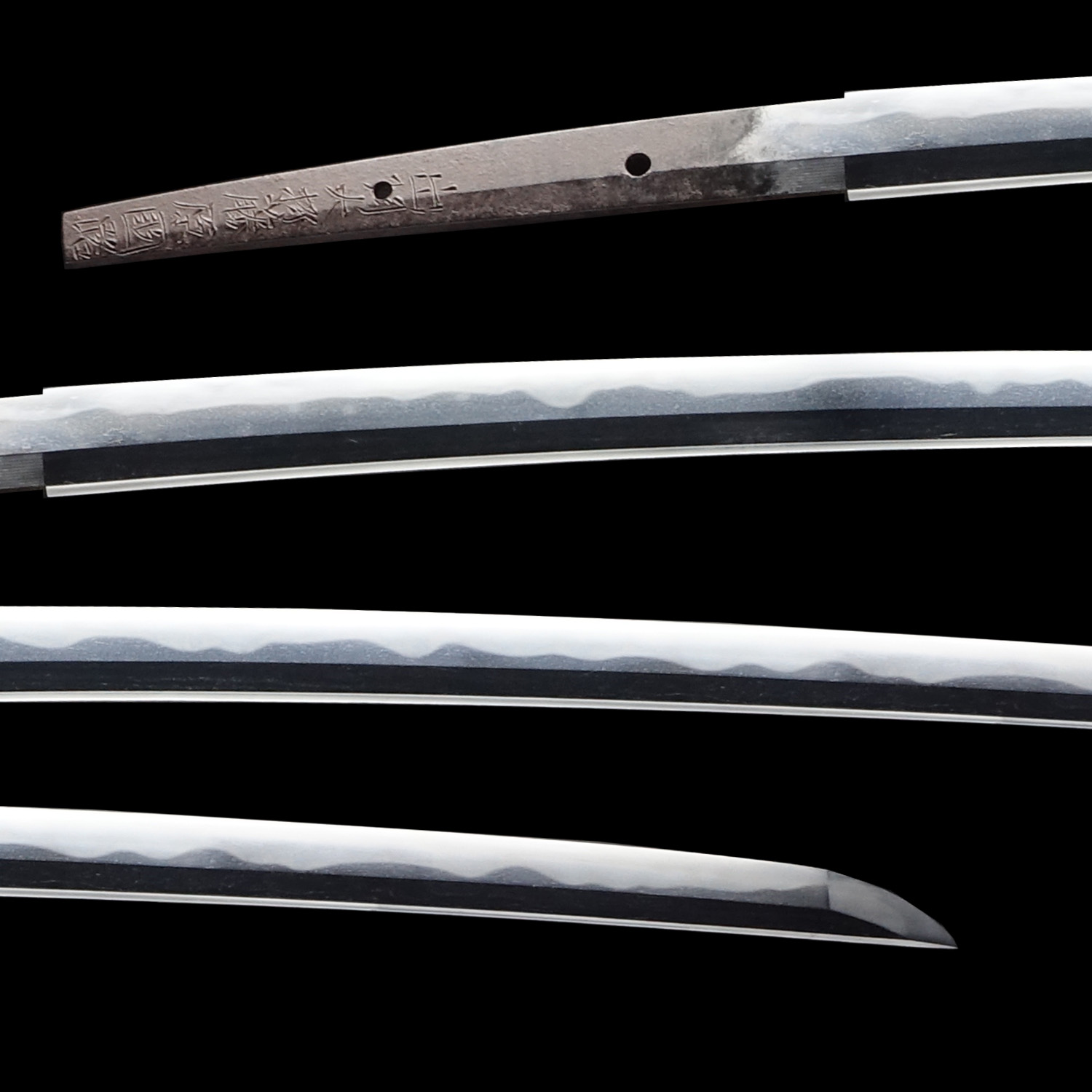
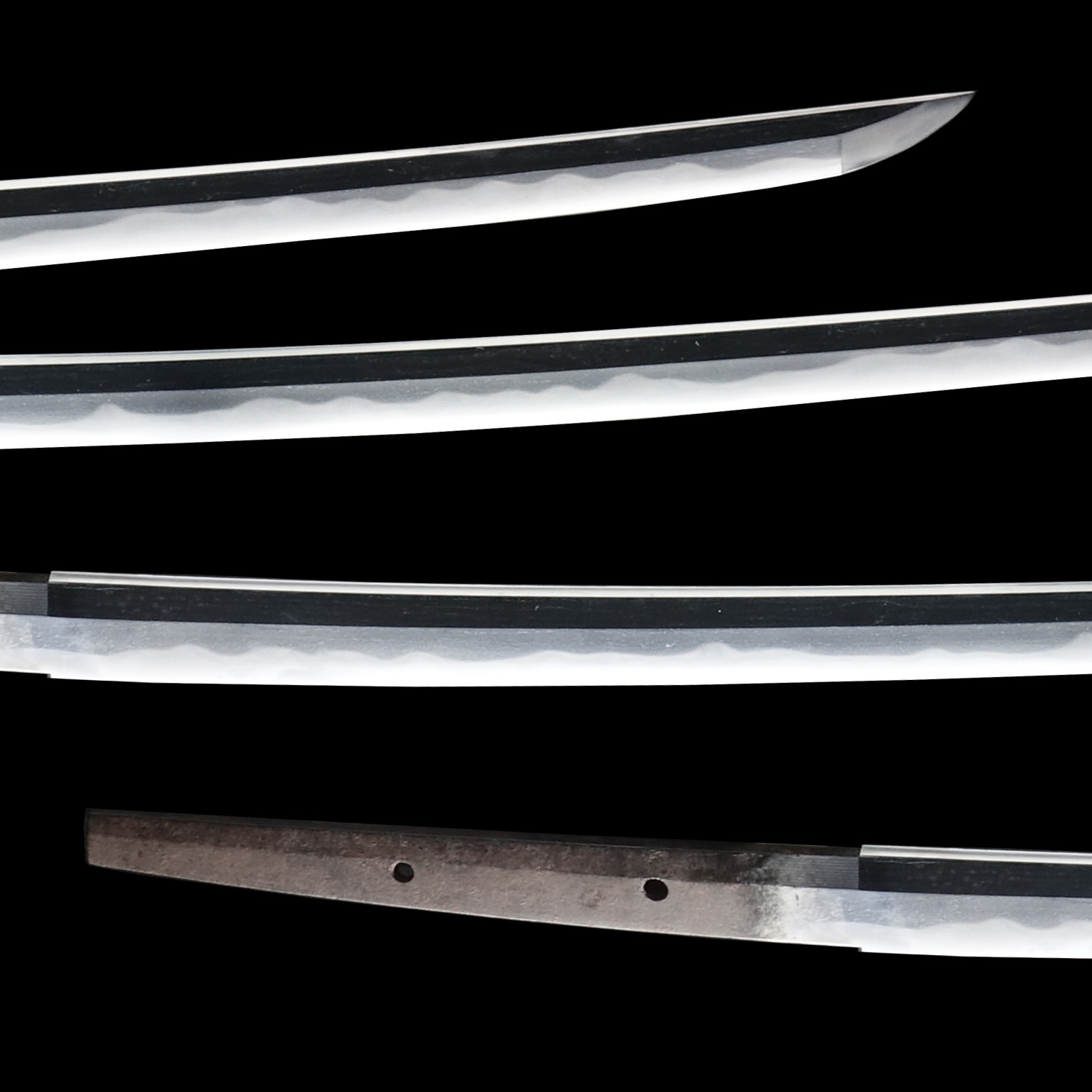


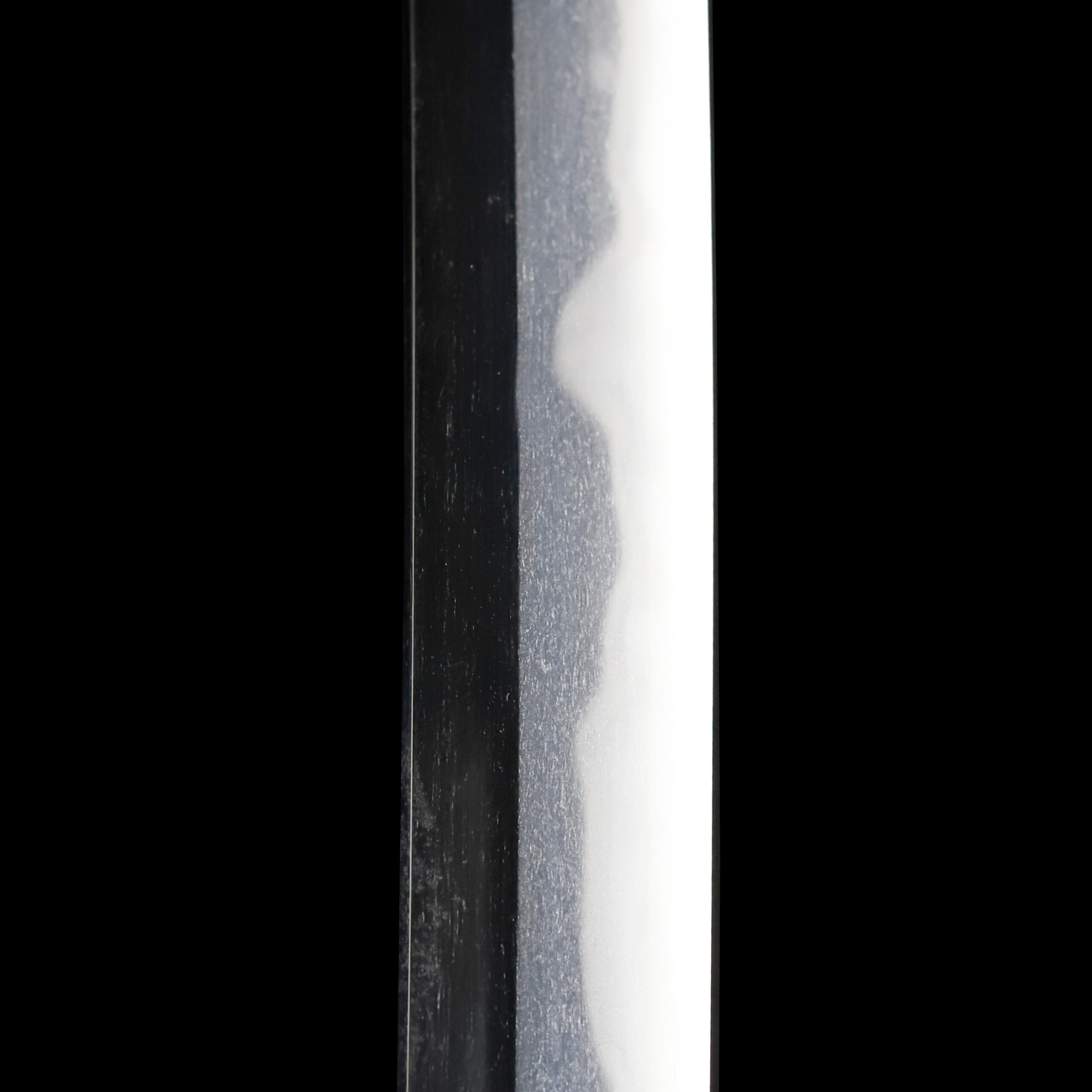

Nakago:Nakago is the tang of the Japanese sword.
Japanese swordsmiths left the black rust on the tang because it prevents red rust while the tang is in its handle. And the discoloration of the tang was created over time, and it is a great indicator for a Japanese sword specialist to estimate when the sword was forged.

Koshirae: Koshirae is the mounting of the Japanese sword. There are several parts that consist of Koshirae such as Saya(Scabbard), Tsuka(Handle), Tsuba(Handguard).

Fuchi-Kashira:A pair of matching sword fittings that cover the upper and bottom parts of its sword hilt.
The surface of this Fuchi Kashira is decorated with a geometric pattern. This pattern creates the illusion of a continuous hexagonal design by laying out the cubes without gaps. The principal motifs of this Fuchi Kashira’s design are birds. You would find the figures of several birds. We estimate these birds are wild geese, migratory birds representing autumn. Some are flying in the sky, and others are resting. In addition, a pine tree is engraved on this Kashira part.

Tsuka and Menuki:Tsuka is the handle of the Japanese sword and Menuki is its decoration.
Seeing from the gaps of the Tsukamaki thread, it seems some kinds of plants are designed for this Menuki. One of the flowers that composes its motif is probably a crysanthemum. A long time ago, the chrysanthemum was used as a medicine for obtaining a long life in the continent, and it was brought to Japan with this thought in the Nara period (648-781). The chrysanthemum is a flower that symbolizes fall, and people have appreciated it very much since ancient times. Since its petals form radially, the chrysanthemum has been likened to the sun. That is why this flower pattern is treated as the symbol of perpetual youth and longevity or good health.
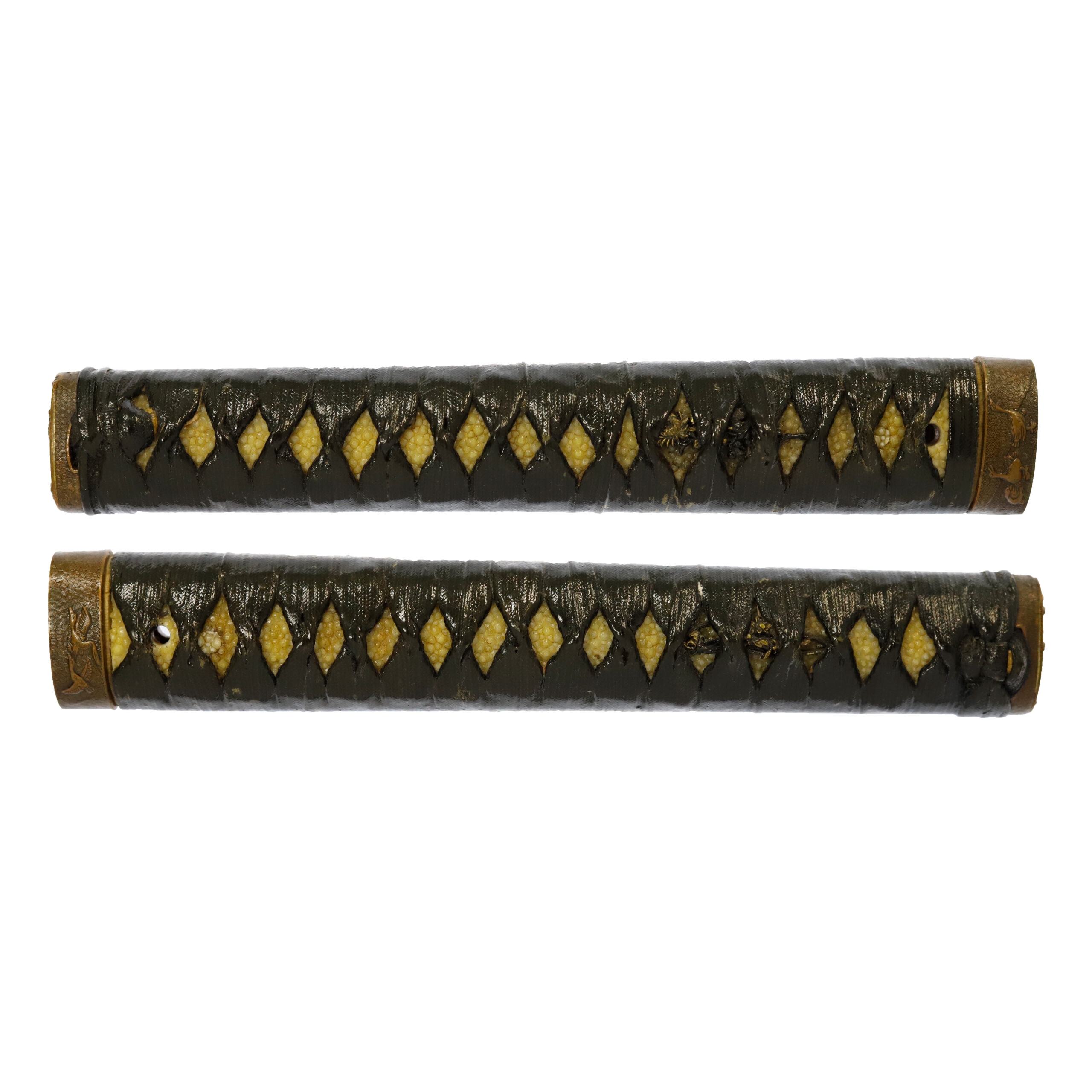
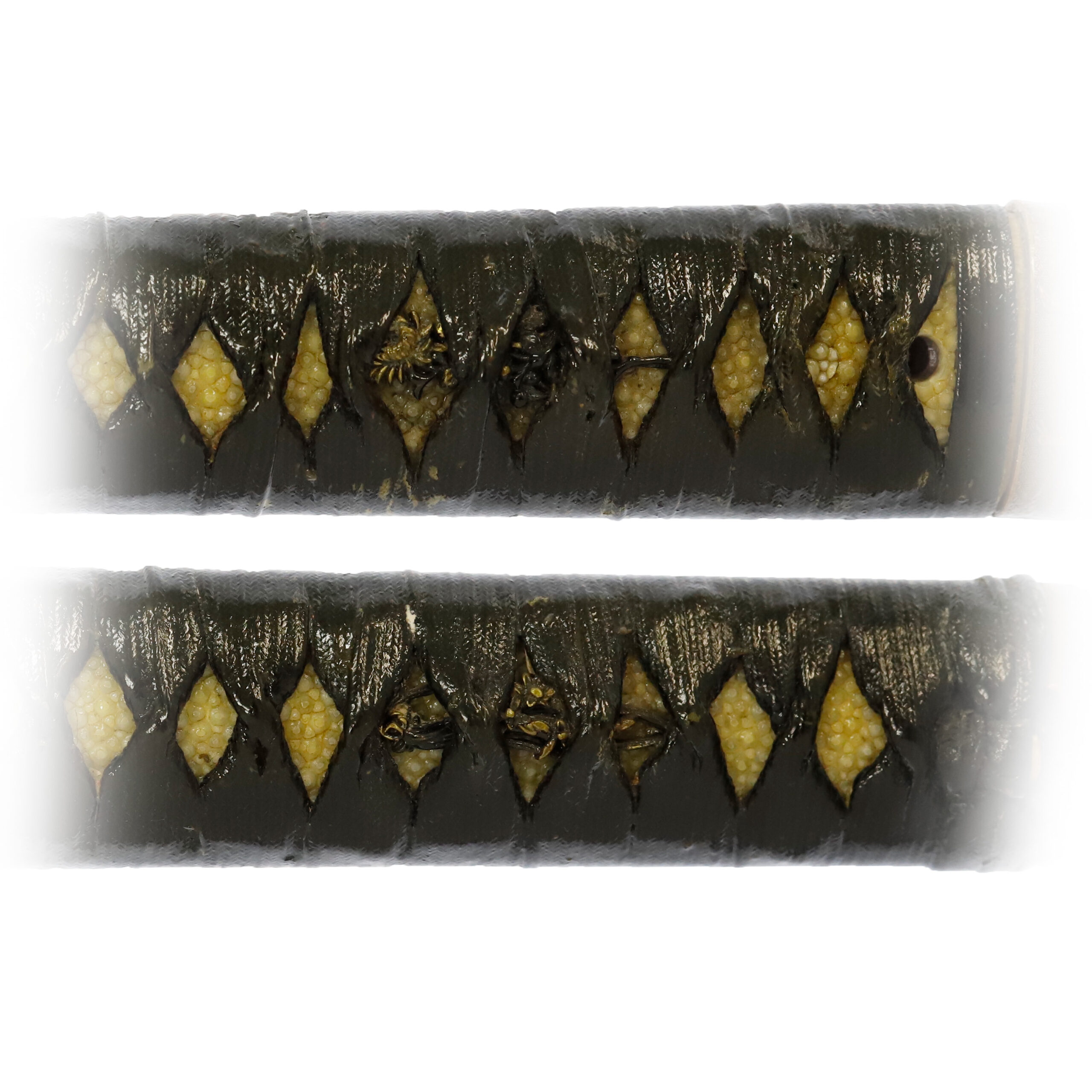
Tsuba and Habaki:Tsuba is the handguard for the Japanese Sword and Habaki is the equipment to make the blade not touch its scabbard inside. It prevents the blade from getting rusty and chipped.
This Yotsu-Mokkou (四ツ木瓜) shaped Tsuba has an ornamental look thanks to its design. Golden paint is effectively used here and there, and this coloring adds decorativeness to this work.
The theme of this Tsuba’s design is related to the Junishi (十二支, the twelve signs of the Chinese and Japanese zodiac). On the front, clockwise from the apex, you would find the figure of six animals who are the member of this group: Ne (子, mouse), Ushi (丑, cow), U/Usagi (卯, rabbit), Tatsu (辰, dragon), Mi (巳, snake), and I/Inoshishi (亥, boar).
On the other hand, the rest of the six animals are engraved on the backside: Saru (申, monkey), Tora (寅, tiger), Hitsuji (未, sheep), Tori (酉, chicken), 戌 (Inu, dog), and Uma (午, horse). It is challenging to say for certain which is a horse, dog, or boar on this screen; however, judging from the kinds of other animals depicted on this Tsuba, we believe these animals are quoted from the Junishi idea.
The animals assigned to the Junishi are said to have auspicious meanings. For example, mice were treated as a symbol of prosperity because of their high fertility. Cows are a symbol of strength and are said to represent tenacity and loyalty. Tigers symbolize bravery, and rabbits symbolize leaps and progress. The dragon’s symbolism was influenced by continent-derived ideas and regarded as a symbol of power. Snakes were regarded as a symbol of eternity and rebirth because they grow by repeatedly shedding their skin. Other animals have also been thought to have various connotations, such as health, plentiful harvests, safety for families, prosperity in business, etcetra.
There are various theories about the details of the Junishi legend. Its rough outline is that the twelfth animals that arrived early at the feast that god held on New Year’s Day were nominated as the representative for the year. Each animal has a rustic meaning, and the Junishi itself has been treated as a lucky charm in Japan. It is said that the devotion of people who believed in the mysterious power of animals was linked to the Junishi, and the custom of welcoming the god of the year by decorating animal figurines associated with the twelve zodiac signs of the year in the entrance or living room was born. This belief might have inspired this Tsuba’s design.

Saya: Saya is the scabbard for the Japanese sword.

Authentication Paper:NBTHK TOKUBETSU Hozon Certificate for the blade (No. 121113)
NBTHK, also known as Nihon Bijutsu Touken Hozon Kyokai (the Society for the Preservation of the Japan Art Sword), is one of the oldest Japanese sword appraising organizations in modern-day Japan. They authenticated the blade on March 8th in the 2nd year of Heisei (1990). They appraised it as Tokubetsu Hozon Touken, the blade especially worth preserving for Japanese society. The purchaser will receive this original certificate as well. We can also translate what is written into English and make a PDF file for your record if you request.

Registration Number : Tokushima 24030
The Board of Education in Tokushima prefecture issued a registration paper for this sword . It is called Jyu Token Rui Torokusho(銃刀剣類登録証). Bunkacho(The Agency for Cultural Affairs) acknowledges a Japanese sword with this paper as a work of art.
The sword needs to be traditionally hand-forged and made of Tamahagane carbon steel to be registered in the system. With this paper, its owner in Japan can legally own an authentic Japanese sword. Based on this registration number, we will apply for its export permit.
This paper will need to be returned to the board of education when the sword is being shipped abroad, but you can receive a copy of it. An English translation of this registration paper is available on request.
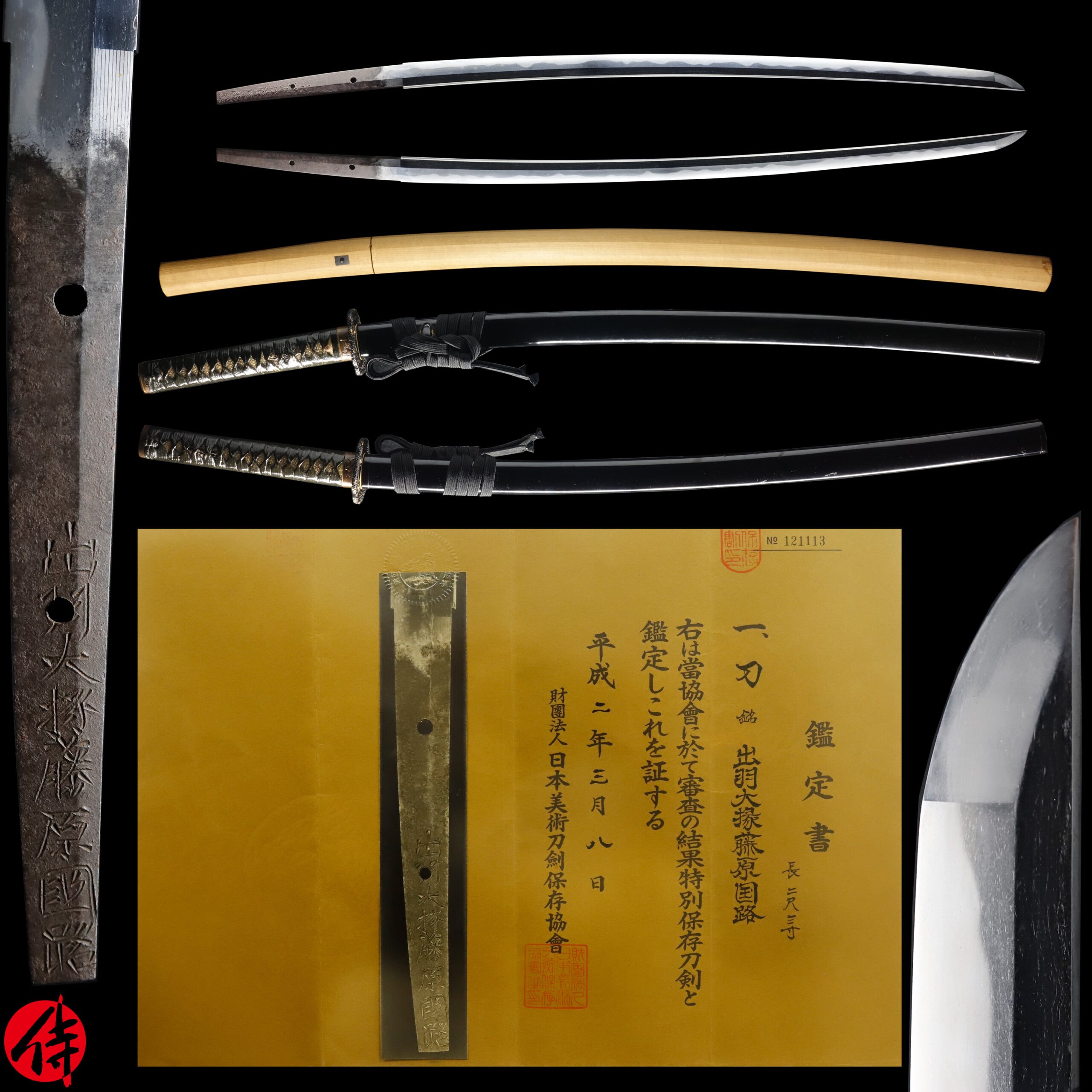
—————————————————————–
【About us】
Samurai Museum is located in Tokyo, Japan, exhibiting antique artifacts related to the Samurai history. Samurai Museum Shop is the place for those who are interested in Japanese culture and craftsmanship. We deal with antique Samurai swords/armor, traditional crafts made in Japan and so on.
【Japanese Sword& Export Process】
The Japanese swords we deal with are hand-forged edged swords made in Japan. It was made from the traditional carbon steel called TAMAHAGANE(玉鋼). Samurai Museum is familiar with the proper legal procedure for an antique/ authentic Japanese sword to be exported from Japan. We have sent more than 500 Japanese swords for the past three years (~2023) to amazing owners who appreciate its historical value.
Each Japanese sword is registered under the Agency for Cultural Affairs and the Board of Education in Japan. They issue a registration paper for each Japanese sword for its owner in Japan to legally possess it. The Japanese sword with its registration paper means it was traditionally hand-forged in Japan.
To legally export the sword from Japan to other countries, we will have to apply for its permit to the Agency for Cultural Affairs(Bunkacho) and return the original registration paper to the Board of Education. It normally takes around 2-4 weeks to receive this permit after submitting required documents. And we would like you to expect at least 1-1.5 months for your order to arrive at your given address after you ordered. For more detailed info, please click here.
It is allowed for residents in Japan to own authentic Japanese swords without a special license as long as they come with registration papers. Please feel free to contact us if you are a resident of Japan, whether temporarily or permanently. We will also assist you when you leave Japan and need to obtain an export permit. If you live in Japan, please click here before you make a purchase.
【Payment Method】
We accept payment through Stripe (Credit card), PayPal, Apple Pay or ChromePay, all of which are secure payment methods. Also, you don’t need to make an account on Stripe for the checkout. If you prefer other payment method, please contact us. After confirming your payment, we will apply for an export permit. You may either pay in JPY, USD, AUD, CAD,EUR CHF or GBP. The price is set in Japanese Yen. Prices in other currencies are automatically calculated based on the latest exchange rate.

* If the amount is above 1 million JPY, Stripe or wire transfer will be the only options for payment.
【Shipping】
We have shipped authentic Japanese swords to the USA, UK, Canada, Mexico, Germany, France, Hong Kong and Australia. If you don’t live in these countries and like to order, please contact us first before making a purchase. We offer Free International Shipping as long as we can send antique Japanese swords by EMS.
We normally ship by EMS(Express Mail Service) provided by Japan Post. We will send you a tracking number for your order as soon as we hand it to the post office. We will put 100 % insurance on the shipping document without any extra charge. Based on the total amount, there might be a duty tax or other fee for you to pay, depending on the countries. We use package cushioning to protect the item and put it in a PVC pipe, which is one of the most secure packages because of its durability.
It will normally takes 5-14 days for the item to arrive at your given address after we dispatch it. Time of delivery is estimated as accurately as possible by the carrier but does not take into account any delays beyond our control such as by inclement weather, post office holiday seasons.
* If you live in Australia and like to purchase an authentic Japanese sword, please click here to know the detail.
*Please keep in mind that due to the spread of COVID-19, there might be delays in shipping. If you like to know the detail about shipping, please feel free to ask us.

【Review】
Here is one of the reviews we received from a customer who purchased an authentic Japanese sword from us. For more reviews, please click here.
“My experience overall with the whole process was wonderful. I had many questions about the history and process to purchase these treasures. All my questions were answered very timely and complete. The staff is very knowledgeable and very well versed if any questions do arise.”
【How to make sure the condition】
Please keep in mind that what you are going to purchase is an antique item. We uploaded high resolution photos for you to check its condition thoroughly. If you like to see more photos with different angles, please feel free to contact us. We will be happy to send them to you so that you can make informed decision. It is essential for us to know that you are happy with your choice of a sword. and we are prepared to use the best of our ability to serve you.
【How To Contact Us】
Please contact us through email, Facebook Messenger or Live Chat if you have any questions. You can find each icon on the right side of the website. Please click one of them to reach us. We will reply to you within 1-2 business days.
【The Art of Nihonto (Japanese Sword)】
Samurai’s history is a profound, eloquent legacy of ancient Japanese warriors in which millions of people worldwide are being fascinated. If you like to find out the art of Nihonto, please click here.
【A Guide to Japanese Sword Maintenance】
After acquiring an genuine Japanese sword, it is also important to know how to take good care of it. Here is the special video for you. Mr. Paul Martin, Japanese sword expert, shows you how to give proper maintenance to your sword. By mastering how to clean the Japanese sword, its aesthetic beauty will last forever.
When you purchase a Japanese sword from us, you can get a Free Japanese sword maintenance kit. It comes with four tools(Choji Oil, Uchiko Whetstone Powder, Peg remover, Oil Applicator). By watching the video instruction above , you can enjoy learning how to maintain your Japanese sword while appreciating it. If you have any difficulty assembling the sword or cleaning the blade, you can feel free to contact us.


MORE ANTIQUE JAPANESE SWORD FOR SALE
SWORDS WITHOUT CERTIFICATES FOR SALE
LEARN JAPANESE SWORD TERMINOLOGY
Thank you for reading all the information on the page. If you have any difficulty choosing the right Japanese sword for you, we will be more than happy to help you find the one that speaks to you the most. Please feel free to contact us.







